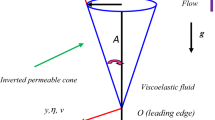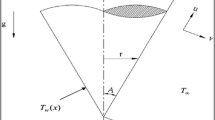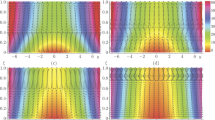Abstract
Thermal entry region solutions are analytically determined for horizontal, co-current laminar flow of immiscible liquids in direct contact, inside circular tubes and parallel plate channels. The related eigenvalue problem for such a composite media is readily solved by extending the ideas in the recently advanced sign-count method. It is assumed a core-annular flow configuration for circular tubes and sheat-core flow for the parallel plates channel, without consideration of interface instabilities and stratified flow. First, the velocity problem is solved for fully developed flow and pumping power expressions established for different operating conditions. Then, the temperature problem is analytically handled to yield expressions for quantities of practical interest such as total heat exchange rates, along the duct length and, again, for different flow rates and pressure drop requirements. The analysis is illustrated through consideration of an application dealing with pumping of a very viscous oil with the addition of an external thin layer of a less viscous fluid (water). Pumping power and total heat exchange are then evaluated for both geometries and critically compared to the single fluid flow problem.
Zusammenfassung
Hier sind Lösungen für die thermische Eintritts-strecke von horizontalen, laminaren Gleichströmungen in unvermischbaren Flüssigkeiten, die in direktem Kontakt untereinander sind, analytisch bestimmt worden. Die Lösungen gelten für Gleichströmungen in Röhren und in parallelen flachen Kanälen. Das betreffende Eigenwertproblem für solch ein zusammengesetztes Medium ist vollkommen mit dem Gedanken des kürzlich weiterentwickelten Zeichenzählverfahrens gelöst worden. Für die Rohre sind kreisring- und kernförmige Strömungen und für die parallelen Plattenkanäle Schichtkernströmungen angenommen worden. Hierbei ist die Grenzflächeninstabilität nicht in Betracht gezogen worden. Als erstes ist das Geschwindigkeitsproblem für eine vollkommen entwickelte Strömung gelöst und es sind Ausdrücke für die Pumpleistung für verschiedene Betriebsbedingungen ermittelt worden. Dann ist das Temperaturproblem analytisch behandelt worden, um Ausdrücke für die Größen von praktischem Interesse zu erzielen, wie die gesamte Wärmeaustauschrate über die Kanallänge für verschiedene Strömungsgeschwindigkeiten und Druckverlustanforderungen. Die Berechnung ist durch die Betrachtung eines Anwendungsbeispiels veranschaulicht worden, bei dem sehr zähflüssiges Öl mit einer zusätzlichen äußeren, dünnen Schicht, die weniger zähflüssig ist, gepumpt wurde. Die Pumpleistung und der gesamte Wärmeaustausch sind für beide Geometrien ausgewertet und kritisch mit dem einfachen Strömungsproblem von Fluiden verglichen worden.
Similar content being viewed by others
Abbreviations
- k m :
-
thermal conductivities (m=1 or 2)
- \(\hat k = \frac{{k_1 }}{{k_2 }}\)=k 1/k 2 :
-
thermal conductivities ratio
- \(\bar K = - \frac{{dp}}{{dz}}\) :
-
axial pressure gradient term
- \(\dot m\) :
-
total flow rate
- \(\dot m_m \) :
-
flow rates for each stream (m=1 or 2)
- L :
-
duct's length
- r 1 :
-
dimensional interface position
- r 2 :
-
tube radius or half the distance between parallel-plates
- T 0m :
-
inlet fluid temperatures (m=1 or 2)
- T w :
-
duct wall temperature
- \(\bar u\) :
-
average flow velocity
- u m(r):
-
velocity fields (m=1 or 2)
- \(\bar u_m \) :
-
average flow velocities for each stream (m=1 or 2)
- \(\bar \alpha \) :
-
as defined in Eq. (8e)
- \(\hat \alpha = \frac{{\alpha _1 }}{{\alpha _2 }}\) :
-
thermal diffusivities ratio
- α m :
-
thermal diffusivities (m=1 or 2)
- δ :
-
dimensionless interface position
- λ i :
-
eigenvalues of problem (10)
- ψ mi(R):
-
eigenfunctions of problem (10), (m=1 or 2)
- \(\hat \mu = \frac{{\mu _2 }}{{\mu _1 }}\) :
-
viscosities ratio
- μ m :
-
viscosities (m=1 or 2)
- m=1 or 2:
-
internal and external fluid quantity, respectively
- i :
-
order of eigenvalue and related quantities
- *:
-
quantities for single fluid (internal) flow situation
References
Shah, R. K.; London, A. L.: Laminar flow forced convection in ducts. New York: Academic Press 1978
Cotta, R. M.; Özisik, M. N.: Thermally developing concurrent-flow circular double-pipe heat exchanger analysis. 8th int. Heat Transfer Conf., San Francisco, v. 6 (August 1986) 2805–2810
Rice, R. G.; Marshall, R. J.: Short penetration models for direct and indirect contact, cocurrent heat transfer. Can. J. Chem. Eng. 53 (1975) 453–455
Bentwich, M.; Sideman, S.: Temperature distribution and heat transfer in annular two-phase (liquid-liquid) flow. Can. J. Chem. Eng. 42 (1964) 9–12
Yalvac, S.; Kisakurek, B.: Direct contact heat transfer between immiscible liquids in turbulent pipe flow. Two-Phase Flow and Heat Transfer, V. III, Proc. of Nato Advanced Study Institute, Istanbul-Turkey. (August, 1976) 16–27
Leib, T. M.; Fink, M.; Hasson, D.: Heat transfer in vertical annular laminar flow of two immiscible liquids. Int. J. Multiphase Flow 3 (1977) 533–549
Everage, A. E. Jr.: Theory of stratified bicomponent flow of polymer melts. I — Equilibrium newtonian tube flow. Trans. Soc. Rheology 17 (1973) 629–646
Ooms, G.; Segal, A.; Vendeer Wees, A. J.; Meerhoff, R.; Oliemans, R. V. A.: A theoretical model for core-annular flow of a very viscous oil core and a water annulus through a horizontal pipe. Int. J. Multiphase Flow 10 (1984) 41–60
Oliemans, R. V. A.; Ooms, G.; Wu, H. L.; Duijvestijn, A.: Coreannular oil/water flow: — The turbulent-lubrificating-film, model and measurements in a 5 cm pipe loop, Int. J. Multiphase Flow 13 (1987) 23–31
Bird, R. B.; Stewart, W. E.; Lightfoot, E. N.: Transport Phenomena. New York: John Wiley 1960
Wang, C.; Chester, C.; Charles, M. E.: Cocurrent stratified flow of immiscible liquids: — Velocity distribution and pressure gradient in the laminar-laminar and laminar-turbulent regimes. Can. J. Chem. Eng. 59 (1981) 668–676
Agrawall, S.S.; Gregory, G. A.; Govier G. W.: An analysis of horizontal stratified two-phase flow in pipes. Can. J. Chem. Eng. 51 (1973)
Mikhailov, M. D.; Özisik, M. N.: Unified analysis and solutions of heat and mass diffusion. New York: John Wiley 1984
Cotta, R. M.; Nogueira, E.: On the eigenvalues basic to diffusion through composite media. Appl. & Computational Math. 7 (1988) 201–213
Cotta, R. M.; Özisik, M. N.: Laminar forced convection of power-law non-newtonian fluids inside ducts. Wärme-Stoff-übertrag. 20 (1986) 211–218
Author information
Authors and Affiliations
Rights and permissions
About this article
Cite this article
Nogueira, E., Cotta, R.M. Heat transfer solutions in laminar co-current flow of immiscible liquids. Wäarme- und Stoffübertragung 25, 361–367 (1990). https://doi.org/10.1007/BF01811560
Received:
Issue Date:
DOI: https://doi.org/10.1007/BF01811560




